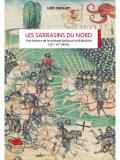The aim of this work is to establish how the crusades against the pagan peoples of the Baltic region in the later Middle Ages were perceived in the French-speaking parts of Western Europe; these are taken to comprise the kingdom of France and much of the Low Countries, as well as England, whose elites had access to Francophone culture. It draws on a great variety of sources in both Latin and French, including narrative histories, chivalric biography, encyclopaedic works, religious and moralising treatises, as well as imaginative literature in both poetry and prose.
The book is structured in four parts, each consisting of two chapters. Part I surveys Western knowledge of the geography and ethnicities of the Baltic lands from the time of Ptolemy and Tacitus up to the period between the fall of Acre (1291) and the writing of Peter von Dusburg’s chronicle (1326/1330), which Chollet identifies as representing a major shift in the character of crusading; while the Baltic campaigns had previously been largely sustained by ecclesiastical and political powers of the Holy Roman empire and Scandinavia, the loss of the Holy Land meant that crusaders from France, the Low Countries and England increasingly looked to north-eastern Europe as an alternative. The remainder of the book is devoted to the wars launched from the Teutonic Order state in Prussia against the grand duchy of Lithuania, by now the last pagan power in Europe. Part II describes the nature of these expeditions, which were known even in French as rèses, from the German term reysa. The crusaders had little interest in conversion; their goal was to win honour in the eyes of their peers, and campaigns which involved the traversing of a wilderness of forest and marsh, with ground covered in snow or ice, appealed to men who had been brought up on tales of chivalric romance. They also welcomed the opportunity to hunt exotic beasts such as bison and aurochs, so that Chollet convincingly categorises much of the motivation of the crusaders as ‹touristic›. By contrast, clerical voices were increasingly critical of the Teutonic Order and its Western guests, regarding the wars against Lithuania as occasions for vainglory which only diverted resources away from the recovery of the Holy Land. Part III discusses the major political shift brought about by the conversion of Jogailo (known in Polish as Władyslaw Jagiełło), grand duke of Lithuania, on his marriage to Jadwiga, heiress to the kingdom of Poland in 1386–1387. One would have liked more analysis of the crucial period from this point up to the crushing defeat of the Teutonic Order by a Polish-Lithuanian coalition at Tannenberg in 1410; it remains problematic given the number of important crusaders (such as Marshal Boucicaut and the future Henry IV of England) who travelled to Prussia during this period to fight an enemy which now claimed to be Christian. However, Chollet goes on to demonstrate how by the time of the Council of Constance, the Lithuanians and their Polish allies were able to largely demolish the religious and intellectual case for the crusades against them, and indeed were able to represent themselves as a new bulwark of Catholic Christianity against Orthodoxy and the new threat from the Mongols. Part IV is in many ways the most interesting section of the book, as it brings out the divergence of views regarding Lithuanian paganism. Clerical authors certainly showed curiosity about practices such as ritual cremation, but had little opportunity or inclination to establish the true nature of the pagan faith, seeing its deities and cultic sites as diabolic manifestations; the crusaders themselves had no interest in paganism other than to bring back captives or converts who could be displayed as evidence of their deeds abroad, although by characterising their enemies as Saracens (the Sarrasins of the book’s title) they could identify themselves with earlier crusaders to the Holy Land.
The book draws on a great range of research in English, German and French as well as Polish and Lithuanian. Its great merit is that it brings together so many diverse sources (which, despite the stated scope, include a significant number in medieval German) to illustrate the often startling divergence of Western opinion on the crusades; alongside well-known authors (such as Guillaume de Machaut and Philippe de Mézières) there are others (such as Jean d’Outremeuse and Johann von Winterthur) who have been little studied in this wider context, and whose works would in many cases warrant further investigation. One would have liked more analysis of the military and political confrontation between Lithuania and their Teutonic-crusader opponents, and less of the long prehistory of the crusades. Nevertheless, Les Sarrasins du Nord is to be welcomed as the first major study in French on the crusades against Lithuania; an English translation – perhaps abridged – would be a welcome resource for teaching and research.
Zitierweise:
Murray, Alan V.: Rezension zu: Chollet, Loïc: Les Sarrasins du Nord. Une histoire de la croisade balte par la littérature (XIIe –XVe siècles), Neuchâtel 2019. Zuerst erschienen in: Schweizerische Zeitschrift für Geschichte 72(3), 2022, S. 446-447. Online: <https://doi.org/10.24894/2296-6013.00114>.
